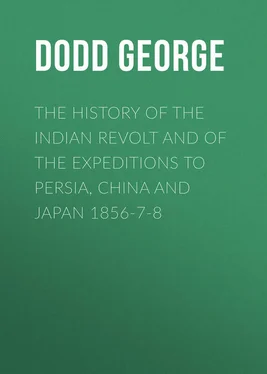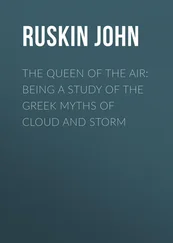George Dodd - The History of the Indian Revolt and of the Expeditions to Persia, China and Japan 1856-7-8
Здесь есть возможность читать онлайн «George Dodd - The History of the Indian Revolt and of the Expeditions to Persia, China and Japan 1856-7-8» — ознакомительный отрывок электронной книги совершенно бесплатно, а после прочтения отрывка купить полную версию. В некоторых случаях можно слушать аудио, скачать через торрент в формате fb2 и присутствует краткое содержание. Жанр: foreign_antique, foreign_prose, на английском языке. Описание произведения, (предисловие) а так же отзывы посетителей доступны на портале библиотеки ЛибКат.
- Название:The History of the Indian Revolt and of the Expeditions to Persia, China and Japan 1856-7-8
- Автор:
- Жанр:
- Год:неизвестен
- ISBN:нет данных
- Рейтинг книги:3 / 5. Голосов: 1
-
Избранное:Добавить в избранное
- Отзывы:
-
Ваша оценка:
- 60
- 1
- 2
- 3
- 4
- 5
The History of the Indian Revolt and of the Expeditions to Persia, China and Japan 1856-7-8: краткое содержание, описание и аннотация
Предлагаем к чтению аннотацию, описание, краткое содержание или предисловие (зависит от того, что написал сам автор книги «The History of the Indian Revolt and of the Expeditions to Persia, China and Japan 1856-7-8»). Если вы не нашли необходимую информацию о книге — напишите в комментариях, мы постараемся отыскать её.
The History of the Indian Revolt and of the Expeditions to Persia, China and Japan 1856-7-8 — читать онлайн ознакомительный отрывок
Ниже представлен текст книги, разбитый по страницам. Система сохранения места последней прочитанной страницы, позволяет с удобством читать онлайн бесплатно книгу «The History of the Indian Revolt and of the Expeditions to Persia, China and Japan 1856-7-8», без необходимости каждый раз заново искать на чём Вы остановились. Поставьте закладку, и сможете в любой момент перейти на страницу, на которой закончили чтение.
Интервал:
Закладка:
Aurungzebe, the last Mogul who maintained the real greatness of the native court of Delhi, became emperor in 1659, by an act of violence against his royal parent. He captured the cities of Hyderabad, Bejapore, and Golconda, and extended his dominions nearly to the limits of the Carnatic. There were, however, the germs of mischief perceptible in his reign: the warlike Hindoo tribe of Mahrattas rose into note; and though they were frequently defeated in the plains by the troops of Aurungzebe, he was unable to subdue the country inhabited by these mountaineers. Sevajee, the founder of the Mahratta empire, gradually conquered the greater part of the Deccan; he died in 1682, and his son, Sambajee, was put to a cruel death by Aurungzebe in 1689; but the Mogul emperors of the north could never afterwards wholly subdue the Mahratta rajah of the south. Aurungzebe was illiberal towards his Hindoo subjects; and this circumstance threw them into closer sympathy than would otherwise have been produced with the rude Mahratta mountaineers. He was not without ability; but he had neither the wisdom nor the justice to maintain his wide-spreading empire in a state of greatness; and when he died in 1707, he left the Mogul power at Delhi much weaker than he found it at the period of his seizure of the crown.
Nadir Shah, although never emperor of Delhi, must be named here as one who contributed to the crumbling of the Mogul dynasty. This man, one of the grand barbarians whom Central Asia has so often sent forth, was the son of a sheep-skin cap-maker. He became a soldier of fortune; then the leader of a band of robbers; then governor of Khorassan; then Shah of Persia; then a formidable opponent of the Turks and the Afghans; and then a scourge to India. While devastating Afghanistan in 1738, he required of the Emperor of Delhi that none of the Afghans should find shelter in his (the Mogul’s) dominions; but as no attention was paid to his demands, he marched into Hindostan in the following year, and entered Delhi with an enormous army on the 8th of March. He seized the whole of the vast treasures which had been amassed in the course of nearly two centuries by the Mogul monarchs. The citizens not being so submissive as he wished, he ordered a general massacre. His commands were only too well obeyed; for, from sunrise till noon, the inhabitants were slaughtered by his soldiers without distinction of sex or age. At the earnest intercession of the emperor, Nadir ordered the butchery to be stopped. Where the estimates of human beings murdered varies from 8000 to 150,000, it is clear that no trustworthy data are obtainable; but it is unquestionable that Delhi suffered immensely, both in its population and its wealth. The ruthless despoiler not only refrained from claiming the crown of Hindostan, but he did not make any conquests whatever: he came simply as a Shah of Persia on an errand of vengeance; he remained two months at Delhi; and then departed westward, carrying with him treasures that have been variously estimated at from thirty to seventy millions sterling.
The Delhi monarchs no longer need or deserve our attention; they had fallen from their high estate, and were forced to struggle constantly for the maintenance of their authority. A number of obscure names meet our view after the time of Aurungzebe – Shah Alum, Moez-Eddin, Furrucksir, Mohammed Shah, Ahmed Shah, Alumghir, and Shah Alum II.: each more powerless than the preceding. Now they were attacked by the warlike Mahrattas; now by the Rajpoots, a military Hindoo tribe which had never been wholly subdued by the Moslems; now by the Sikhs, a kind of Hindoo dissenters, brave and independent in their bearing; now by the Rohillas, an Afghan race, who effected a settlement in the very neighbourhood of Delhi; now by many of the Mohammedan nawabs or viceroys, who, like other Asiatic viceroys in parallel circumstances, were willing to rise on the fall of their masters; now by the competing sons and nephews who surrounded every emperor; and now – more striking in its consequences than all the rest – by the ever-encroaching British.
Nevertheless, amid all this decadence of Mogul power, the natives of Hindostan never ceased to look up to the emperor as the centre of power, to Delhi as the centre of nationality. Their traditions told them of Mahmoud, of Tamerlane, of Baber, of the great Akbar, of Jehanghire, of Shahjehan, of Aurungzebe; and although ruthless barbarities were connected with the names of many of these rulers, there was still a grandeur that impressed the imagination. The Hindoos, it is true, had their sacred associations connected with Benares rather than with Delhi; but their distinct nationality had been almost stamped out of them during eight centuries of Mohammedan supremacy; and they, like the rest, held in reverence the city where the peacock’s throne had glittered on the world.
By what strange steps the descendants of the Great Mogul became pensioners of the East India Company, will be explained presently; but it will be well first to describe Delhi itself.
This far-famed city is situated on the river Jumna, about five hundred miles by road above Allahabad, where the Jumna flows into the Ganges, and nine hundred by road from Calcutta. In the opposite direction, Delhi is nearly four hundred miles from Lahore, and six or seven hundred from Peshawur – so great are the distances between the chief towns in India: distances that terribly hamper the operations of a British army during any sudden emergency. Striking as Delhi may be, it presents but a faint approach in splendour to the city of past days, the home of the grand old Moguls. Of the original Delhi, the natives give the most extravagant account; they even run back to a period three thousand years before the Christian era for its foundation. All that is certain, however, is, that Inderput or Indraprestha, the name of the old city, was the capital of a Hindoo kingdom under a rajah, long before its conquest by the Mohammedans. When or how the original city went to ruin, is not exactly known; but modern Delhi owes its chief adornments to Shahjehan. A traveller from the south or Agra direction is struck with the evidences of ruined Inderput before he sees anything of modern Delhi. ‘Everywhere throughout the plain rise shapeless half-ruined obelisks, the relics of massive Patan architecture, their bases buried under heaps of ruins bearing a dismal growth of thorny shrubs. Everywhere we tread on overthrown walls. Brick mosaics mark the ground-plan of the humbler dwellings of the poorer classes. Among the relics of a remote age, are occasionally to be seen monuments of light and elegant style of architecture, embellished with brilliant colours, gilt domes, and minarets incased in enamelled tiles.’ Some travellers have asserted that they have traced these ruins thirty miles along the Jumna; but these cannot all have been the ruins of one city. Approaching the present Delhi, it is seen that the ruins are spread over a plain, in the midst of which the city is situated; and they give place, after a time, to the tasteful villas of the Europeans who exercise civil or military control within Delhi. Most of these villas are on the site of the once famous garden of Shalimar. On the northern side of the city, close under a ridge of sandstone rocks called the Mijnoon Pahar, are the cantonments – an alternation of bungalows, huts, and groups of trees.
So much for the environs. Although not entitled to take rank among the great cities of the earth, Delhi is nevertheless a considerable place, for it is seven miles in circumference. The Jumna bounds it on the east, while a lofty crenellated wall, of horseshoe shape, completes the boundary on the other sides. This wall has been an object of much attention at different times. As built by Shahjehan, it possessed little strength. When the British obtained ascendency over the city in 1803, the wall was found to be in a ruinous state, without other flanking defences than small circular bastions placed at intervals; the ditch was imperfect; there was scarcely any vestige of a glacis or exterior slope; and the crumbling ruins of dilapidated buildings had been allowed to accumulate all round the wall. Captains Hutchinson and Smith, of the Bengal engineers, were thereupon deputed to restore and strengthen the fortifications. It was determined to establish a series of bastions, with faces and flanks to defend the curtain or plain wall, and to mount them with heavy artillery. The walls were repaired; and to shield them from escalade, they were protected, especially on the river-front, with beams of timber, the sharpened ends of which were pointed at an acute angle downward into the ditch. The ditch was cleared out and deepened; the glacis was made to cover, in some degree, the scarp of the wall; the ground outside was cleared to some distance of ruins and houses; and the ravines were filled up to check the approach of marauding horsemen. To prepare for a rising within the city as well as an attack from without, detached martello towers were constructed, entirely separate from the walls, and accessible from them only by drawbridges; each tower had a gun mounted on a pivot, so that in the event of a tumult in the city, the towers might be occupied by artillerymen, the drawbridges drawn up, and the guns swiveled round to pour a fire upon the insurgents. The gateways of the city were strengthened; outworks were provided in front of some of them, while others were provided with guard-houses and places-d’armes . At a much later date – in 1838 – Lord Auckland caused the walls and towers to be strengthened, and one of the new defences, called the Wellesley Bastion, to be reconstructed.
Читать дальшеИнтервал:
Закладка:
Похожие книги на «The History of the Indian Revolt and of the Expeditions to Persia, China and Japan 1856-7-8»
Представляем Вашему вниманию похожие книги на «The History of the Indian Revolt and of the Expeditions to Persia, China and Japan 1856-7-8» списком для выбора. Мы отобрали схожую по названию и смыслу литературу в надежде предоставить читателям больше вариантов отыскать новые, интересные, ещё непрочитанные произведения.
Обсуждение, отзывы о книге «The History of the Indian Revolt and of the Expeditions to Persia, China and Japan 1856-7-8» и просто собственные мнения читателей. Оставьте ваши комментарии, напишите, что Вы думаете о произведении, его смысле или главных героях. Укажите что конкретно понравилось, а что нет, и почему Вы так считаете.












